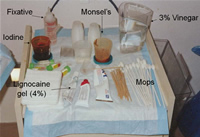High resolution anoscopy
Who may be recommended to have a High Resolution Anoscopy (HRA)?
HRAs are only performed on people in whom there is a concern that anal cancer may develop, and in people who are participating in clinical trials. It is only performed in a small number of centres around Australia. There is usually no charge for the procedure or tests.
Is any preparation required?
Your routine hygiene measures are all that is necessary. The anal canal does not contain any faecal material, unless you actively want to go to the toilet.
It is currently not clear whether you should avoid douching (washing the inside of the anus) on the day of the procedure. However, some specialists think that douching may wash away some of the cells that we are specifically looking for, so ask that you avoid doing this for 24 hours before you are seen.
What is involved in an HRA?

You will be booked in for a one hour appointment, although the procedure typically only takes around 15-30 minutes. It is performed in a specially equipped, private room.
We ask you to remove the lower half of your clothes and then give you a gown. Using lubricant mixed with local anaesthetic, a small tube (anoscope) is inserted into the anus and then special dyes (5% acetic acid and Lugol's Iodine) are introduced. Sometimes some of the excess dye causes a sensation of wetness on the buttocks.
The specialist will then look inside, using a high powered microscope (a "colposcope"). . If you want to, you can watch what is happening on the television screen. After careful, thorough examination of the area, the specialist may inform you that there are some abnormalities present and that a biopsy may be indicated.
What is involved in an internal anal biopsy?
A biopsy is a small sample of tissue that is sent to the laboratory for analysis. It is removed from inside the anus using special tweezers. Most people undergoing internal anal biopsies do not feel anything, as there are few nerve endings present in this area. The specialist will let you know when this is about to happen. It is quite common for several biopsies to be taken.
What is involved in a perianal examination?
As part of the HRA assessment, the specialist will also carefully examine the outside edge of the anus (the perianal skin), following the application of a dye. If any abnormalities are seen, then a biopsy will be suggested. Local anaesthetic will be used for this, and solution will be applied to promote rapid healing. Stitches are rarely necessary.
What happens after the HRA?
You will be given some pads to place in your underwear, as there is often slight bleeding for 24-48 hours after the procedure. Occasionally there is a further, slight bleed 4-5 days later, as the internal scabs fall off. Opening your bowels can often trigger slight bleeding, but it usually stops very quickly. It is recommended that you do not do anything strenuous (such as going to the gym or swimming) on the day of the procedure. For the following week, you are advised not to have receptive anal intercourse, or to use anal toys. Some people like to increase the fibre content of their diet to help make the stools softer.
If you are concerned about any symptoms developing after the procedure, contact the department for advice.
Healing of the biopsy sites occurs very quickly, usually without any scarring. All procedures are done using sterile or single-use equipment. Infections are very rare, as the lining of the anus has a very strong immune system.
Depending on what is found at the HRA, you may be asked to return in a couple of weeks for the results. At this point, the specialist will discuss any treatments or further follow up advised.